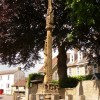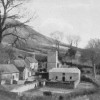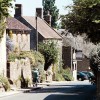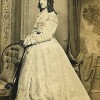Arriving in Loders from the direction of Uploders, which seems quite separate but is within the parish of Loders, there is an opportunity to admire the attractive village street: the houses on either side are mostly of stone, some dating back to the 17th century. To the north and overlooking the village is Waddon Hill, with its strip lynchets. Straight ahead and on a sharp right hand bend in the road is the entrance to the churchyard; continue and you will soon be in Bridport. The only parking is on the street but it is well worth stopping awhile to visit The Church of St. Mary Magdalene.
Loders is an old name believed to be the ancient name for the river Asker from the Celtic words lo (pool) and dour (water.) The place is first recorded in the Domesday Book of 1086 as Lodre and later as Loddres in 1244 and Loderes in 1291. Around 1445 Uploders was separately identified as Uppelodres or Uplodre, the addition simply means higher upstream.
A Benedictine priory was established here in 1109 under the Abbott of Montebourg and St. Mary Magdalene’s was the priory church from 1107 until 1414, when the priory was dissolved. A list of Priors and Vicars in the church informs us that the first known Prior was Baldwin in 1209 and the last Prior between 1401 and 1414 was William Burnell.
In the churchyard are memorials to members of the Gale and Samways families who have been discussed on Dorset Ancestors. There are several large tombs; in best condition is the one for “Mary, wife of Geo.Knight of this parish. Who departed this life the 30th of January 1777.” Another recalls members of the family of Robert and Joan Budden who died in 1762 aged 53 years and December 1787 aged 78 years respectively. John Budden, son of Robert and Joan Budden, died in November 1789 aged 45 years; and William Budden, his brother, died January 1790 aged 41 years; and another son Henry died in April 1807 aged 54 years. There is also reference to their other sons James and Robert and the inscription tells us they died in 1757 and 1802. Some while ago a member of the Budden family set us all an example by bearing most of the cost of repairing the tomb.
This church is a mixture of medieval styles from the 12th to 15th centuries and more recent works carried out during a restoration in the 19th century. Entering through the porch, above which there is a chamber that in earlier times was used by visiting clergy, there is immediately ahead of you an eroded crucifixion relief in Purbeck stone and you will also notice a bell, more about that later. To your left look along the side by the organ pipes and on the west wall you will see the remains of a painting ‘Time and Death’ said to be 17th century. The font is of Purbeck marble from around 1150; the pedestal is later. The chamfered nave windows have two lights separated by a single mullion; the window to the west is stained blue and the other red. Access to the pulpit is by a branch off the stairs to the rood loft.
The main chancel window is dedicated to the memory of Dame Margaret Nepean who died on 26th December 1833, aged 73 years. Along the north wall of the chancel is a stained lancet and its neighbour to the west is a smaller stained window below which is a blocked off doorway; this in earlier times possibly led directly to the priory of which nowadays there is no trace.
The south transcept has a small crucifixion relief and in the south wall a piscina. Here there is a wall memorial to Sir Evan Nepean (1812.) There appears to be, a hagioscope or to give it a simpler name a squint and this allows those seated in the south transcept to view the altar.
The parish registers for Loders are held at the Dorset Record Office in Dorchester and include Baptisms 1636 to 1991, Marriages 1636 to 1985, Burials 1636 to 1993, and Banns 1691 to 1963.
The peal of six bells at Loders was inspected in 2003 by the firm Mears and Stainbank who were to repair the fifth bell, but on inspection it was found to be cracked and has now been replaced. At the same time two of the other bells were taken away to be re-tuned. The last time this happened was in 1927 when the third bell was replaced and the peal re-hung. The earlier third bell is the one presently on display as you enter into the church. It was cast in 1641 its replacement paid for by Sir Edward Le Breton. A brass plate tells us that the 1641 bell, which hung in the tower for nearly 300 years, is kept in memory of Colonel Sir Edward and Lady Breton who lived at Loders Court 1921 –1961 and worshipped in the church. Perhaps its antiquity also guarantees the bells continued existence.
The tenor bell dating from 1626 is the oldest and weighs 28 pounds short of one ton and has a diameter of 48 inches. The fifth, the new bell, is stamped 2003 the fourth is dated 1884; the third was new in 1927; the second dates from 1826 and the treble bell dates from 1843.



